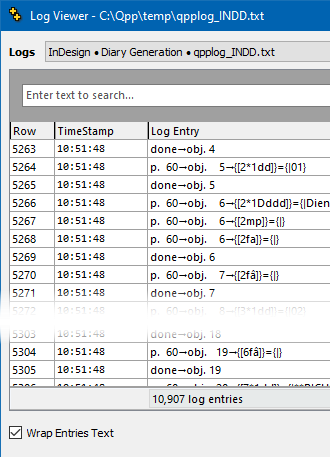
Note that the Log Viewer remains active even when another modal dialog is being displayed. So, for example, during diary generation, it is possible to refresh the diary generation log being displayed.
Viewer Header
As shown in the screenshot on the right, at the top left of the Log Viewer,is a list of available logs.

That list of available logs can be updated at any time by clicking on the Refresh List button.

The list of available logs can also be filtered by selecting one the radio group options on the right of the Refresh List button, as shown above.
Find Zone
Using the radio group at the top of the Log Viewer, you can choose to find text in the displayed log, either using a Filter or using Search.

Filter Mode
When in filter mode, only the rows that contain the search text are displayed, as shown in the image below.
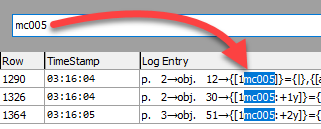
filter mode
In these filtered rows, the occurrences of the search text are highlighted.
Search Mode
When in search mode, all the rows of the log file are displayed, and the occurrences of the search text are highlighted, as shown in the image below.
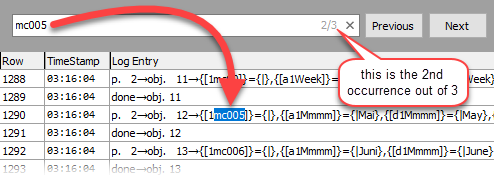
search mode
You can use the Previous and Next buttons to move from on occurrence to the next.
Jump Buttons

As most of the logs can contain thousands of entries, you can use the Top Row and Bottom Row buttons, shown above, to quickly navigate around the displayed log file.
Exporting Parts Of The Log
Q++Studio logs often contain thousands of lines and in many cases you might only be interested in a few lines.
Selection
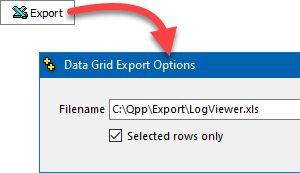
export to Excel
To select only the parts of the log that interest you, there are 2 methods:
•Using the filter mode as described above.
•Manually select blocks of entries and/or individual entries using the usual CTRL+click and SHIFT+click keyboard shortcuts.
These 2 methods can be combined, but in either case, they must be applied before exporting to either to an Excel file, or to the Windows Clipboard.
To export the current log, or parts of it, to an Excel file, select the rows that you wish to export, as described in the Selection section, above, and then click on the Export button, as shown in the image to the above right.
At this stage, you can use the Selected rows only check-box of the export options dialog, shown on the right, to decide if you wish to export the entire log, or just the selected rows.
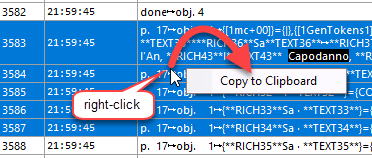
export to the Windows Clipboard
Remember that most logs contain thousands of rows; it rarely makes sense to un-check the Selected rows only check-box and export the entire log as an Excel file.
Export To the Windows Clipboard
To export the current log, or parts of it, to the Windows Clipboard, select the rows that you wish to export, as described in the Selection section, above, right-click on the selection, and then click on the Copy to Clipboard pop-up menu, as shown in the image to the above right.
Once copied to the Clipboard, the copied text can be pasted into any text editor.
See also: Q++Studio Logs and Debugging.
Topic 185040, last updated on 17-Mar-2021